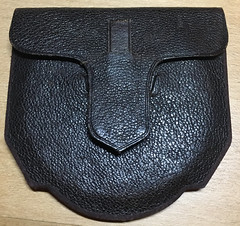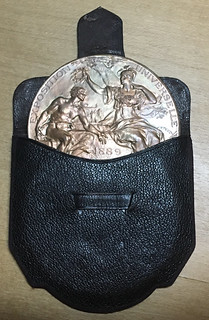
PREV ARTICLE
NEXT ARTICLE
FULL ISSUE
PREV FULL ISSUE
BORDEAUX EXPOSITION MEDAL EPHEMERA"Patrick McMahon mentioned he had medal #3 on the Bacardi Gold Rum bottle and he had some original paper notes from Le Medaillier M. G. Lagarde in Paris. I have a sales plaque from that company and I was wondering if he would share with your readers the information he has on that insert? I for one would be very interested in what it said." Patrick's insert appears below with his response. As always, readers can click on the image to see a larger version on our Flickr archive. Just click again to zoom in. -Editor
From what I can tell, the firm says they have the honor to give information concerning the official medal of the Bordeaux Exposition and they are at your service to fill any orders you might wish to place. You can buy the medal through them in silver, gilt silver, or gold. I don't know for sure but this suggests to me that what you got was bronze no matter what your award level and you could pay to "upgrade." That seems to be the case in a number of fairs. It says you can buy galvano reproductions from them for advertisements, have a medal silvered or gilt, or get the name and title of the winner engraved on it (5 centimes per letter). You can buy different types of presentation boxes for it including one of morocco leather with an easel and another with a pivot inside to allow viewing the front and back of the medal. The paper is cheap and very, very thin and as the image shows: tattered and fragile. It amazes me that it was preserved with the medal the way it was. It has Scotch tape of different vintages holding bits of it together. It was a big part of the reason I bought the medal (which was luckily in much better condition than the paper). Knowing how awards could be customized definitely helps understand the subtle range of differences when you find them. I was very happy to have gotten ahold of a specific list of options for a single Exposition as it was sent to the winners.
For fun, here are images of the étui that the 1889 expo medal came in.   Out of curiosity I tried a search of the Gallica database for the Bibliothèque nationale de France to see if there was any information about Lagarde that could be found quickly
and I located just one easy hit. It is an article from the November 8, 1894 "Bulletin Officiel" for the Exposition Universelle, Internationale et Coloniale in Lyon.
According to Wikipedia that's three days before the Fair closed.
![Bulletin_officiel_de_l'Exposition_de_[...]Exposition_universelle_bpt6k61566972_1](https://c1.staticflickr.com/1/768/49441807242_440eff2abf_n.jpg) ![Bulletin_officiel_de_l'Exposition_de_[...]Exposition_universelle_bpt6k61566972_2](https://c1.staticflickr.com/1/768/49441578776_83e3e295b0_n.jpg) Reference: https://gallica.bnf.fr/ark:/12148/bpt6k61566972 . This is also the fair where French President, Sadi Carnot was assassinated just five months earlier (eventually the subject of Oscar Roty's famous plaquette). The article is a splashy reveal and celebration of the design for the award medal for the fair. It attributes the inside information to Georges Lagarde, a "compatriot" (of Lyon) and director of "Le Medaillier" in Paris. Since this is promoting their medal it goes into great detail about those responsible for it and gushes about their skills and resumés--specifically Henri-Auguste Patey the sculptor and Georges Lagarde the publisher. About Lagarde, the writer says that he published the music award at the exhibition and that he previously published the medal from the city of Toulon commemorating the visit of the Russian fleet that was distributed to 3,000 Russian sailors (1893--presumably the one by Chaplain) and that it was his "maison" that published the medal for the 1889 Exposition. The rest is worth a quick digression. Perhaps a French-speaking subscriber to The E-Sylum with specific numismatic knowledge could take a pass at a more accurate translation of the the whole thing? The language is expressive and a bit confusing but the writer goes on and on about all the steps for producing these medals. It describes the sculptor modeling it in plastiline and refining it in plaster. It alleges that there are only one or two in Paris who can produce the "heavy metal coins for the dies" and that they are so secretive they take no students. This is seemingly contradicted by a knowing description of the process of hardening them and how many times they have to be annealed and how long that takes. This appears to be a recurring theme of the whole message--how long each step takes, including the multiple strikes to produce each medal. 
Janvier medal by Charpentier What is really interesting to me (whether true or not) is the assertion that the preparation of the reductions for the hubs and dies is a complete secret and that only two people in Paris can do it--Tasset and Janvier. The article says that while their systems are different, they are also so secretive that nobody has ever been allowed to visit their studios. But by the end of the decade Janvier is selling his famous reducing lathe and promoting it with that amazing medal by Charpentier.? Near the end the text it says again that the process is laborious and that the slow creation of the works is not appreciated. [My French is rudimentary and I am grateful to my colleague Valentine Lescar for helping me muddle through this!] Going back to Lagarde--with the information he provided to the writer he promotes himself as the publisher of quite a few important medals, including the 1889 Expo medal by Bottée which I sent an image of last week. Here are some pictures of it in its étui which this article suggests is the work of Le Medaillier like the range of à la carte choices in the slip of paper for the Bordeaux medal. There is no way I would ever have made this connection without the 1894 Lyon article and the nudge from Richard Jewell that got me to look for it. The message to everyone here is... even if you have to slab your medals (and you don't)... please don't throw away the soft parts! Those are just as important for connections to the past and telling the unique stories of these objects. ?Some of the participants are invisible without them! To read the earlier E-Sylum articles, see:
 Wayne Homren, Editor The Numismatic Bibliomania Society is a non-profit organization promoting numismatic literature. See our web site at coinbooks.org. To submit items for publication in The E-Sylum, write to the Editor at this address: whomren@gmail.com To subscribe go to: https://my.binhost.com/lists/listinfo/esylum All Rights Reserved. NBS Home Page Contact the NBS webmaster 
|


